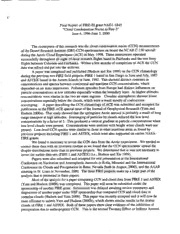
NASA Technical Reports Server (NTRS) 20000110588: Cloud Condensation Nuclei in Fire-3 PDF
Preview NASA Technical Reports Server (NTRS) 20000110588: Cloud Condensation Nuclei in Fire-3
Final Report of FIRE-III grant NAG 1-1845 "Cloud Condensation Nuclei in Fire-3" June 4, 1996-June 3, 2000 The centerpiece of this research was the cloud condensation nuclei (CCN) measurements of the Desert Research Institute (DRI) CCN spectrometers on board the NCAR C-130 aircraft during the Arctic Cloud Experiment (ACE) in May, 1998. These instruments operated successfully throughout all eight 10-hour research flights based in Fairbanks and the two ferry flights between Colorado and Falrbanks. Within a few months of completion of ACE the CCN data was edited and put into the archives. A paper was completed and published (Hudson and Xie 1999) on the CCN climatology during the previous two FIRE field projects-FIRE 1based in San Diego in June and July, 1987 and ASTEX based in the Azores Islands in June, 1992. This showed distinct contrasts in concentrations and spectra between continental and maritime CCN concentrations, which depended on air mass trajectories. Pollution episodes from Europe had distinct influences on particle concentrations at low altitudes especially within the boundary layer. At higher altitudes concentrations were similar in the two air mass regimes. Cloudier atmospheres showed lower concentrations especially below the clouds, which were a result mostly of coalescence scavenging. A paper describing the CCN climatology of ACE was submitted and accepted for publication in the FIRE-ACE special issue of the Journal of Geophysical Research (Yum and Hudson 2000a). That study showed that the springtime Arctic aerosol is probably a result of long range transport at high altitudes. Scavenging of particles by clouds reduced the low level concentrations by a factor of 3. This produced a vertical gradient in particle concentrations when low level clouds were present. Concentrations were uniform with height when clouds were not present. Low-level CCN spectra were similar to those in other maritime areas as found by previous projects including FIRE 1 and ASTEX, which were also supported on earlier NASA- FIRE grants. We found it necessary to revise the CCN data from the Arctic experiment. We needed to correct these data with an inversion routine as we found that the CCN spectrometer spread the droplet distributions more than in previous projects. We determined that is was not necessary to invert the earlier data sets (FIRE 1 and ASTEX) (i.e., Hudson and Xie 1999). Papers were also submitted and accepted for oral presentation at the International Conference on Nucleation and Atmospheric Aerosols in Rolla, Missouri and the International Conference on Clouds and Precipitation in Reno, Nevada (bot h in August, 2000), and the AAA meeting in St. Louis in November, 2000. The three FIRE projects make up a large part of the analysis that is presented in these papers. Most of the analysis for a paper comparing CCN and cloud data from FIRE 1 and ASTEX (Yum and Hudson 2000b) was completed. This paper will soon be submitted under the sponsorship of another FIRE grant. Submission was delayed awaiting review comments and disposition of another paper under NSF sponsorship that compared CCN and cloud data in cumulus clouds (Hudson and Yum 2000). This paper was recently accepted and it will now be most efficient to submit Yum and Hudson (2000b), which shows similar results in the stratus clouds of FIRE 1 and ASTEX. Both of these papers show clear evidence of the inhibition of precipitation due to anthropogenic CCN. This is the second Twomey Effect or Indirect Aerosol Effect,whichispartofthelargestclimateuncertainty.TheseresultsfromFIRE 1andASTEX showanorderofmagnitudelessprecipitationin pollutedcloudscomparedtocleanclouds! Hudson,J.G.,andY. Xie, 1999:Verticaldistributionsofcloudcondensationnucleispectraover thesummertimenortheastPacificandAtlantic Oceans. J. Geophys. Res. 104, 30219- 30229. Hudson, J.G. and S.S. Yum, 2000: Maritime/continental drizzle contrasts in small cumuli. J. Atmos. Sci. In Press. Yum, S.S., and J.G. Hudson, 2000a: Vertical distributions of cloud condensation nuclei spectra over the springtime Arctic Ocean. J. Geophys. Res. In press. Yum, S.S., and J.G. Hudson, 2000b: Maritime/continental drizzle contrasts in stratus. (in preparation for J. Geophys. Res.)
